
Ebook: Theory of the Combination of Observations Least Subject to Errors: Part One, Part Two, Supplement
- Genre: Medicine
- Series: Classics in Applied Mathematics
- Year: 1987
- Publisher: Society for Industrial Mathematics
- Edition: Facsimile
- Language: German
- djvu
G. W. Stewart has done an excellent job for the most part. The English translation is easy to follow and flows naturally. However, Mr. Stewart has engaged in some idiosyncratic choices. For example, he insists on translating "valor maxime plausible" as "most reliable value" rather than the obvious "most plausible value" commonly used both in English and German (by Gauss himself, I might add). He digresses in his Afterword about Laplace's "chutzpa" (what is that about?). At one point he says that a certain proof is "Gauss at his grimmest--a forced march from hypothesis to conclusion..." Isn't all of mathematical proof a steady progression in a beeline toward the Q.E.D.?
The low-water mark of Stewart's gratuitous insults to Gauss is his parting shot: the final sentence of his Afterword, and of the whole book. He says, "What is certain is that Gauss can be as enigmatic to us as he was to his contemporaries." How he can justify this hatchet job is hard to imagine, since any fair-minded reader of this book will be astonished at the clarity of Gauss's thought and exposition.
It is supremely unfortunate that the editors at SIAM chose a translator, skilled though he is, who has a personal antipathy toward one of the great mathematical minds of all history. In spite of the injustices done to him in this volume, Gauss's thinking and achievements shine through, and quite simply dwarf those of his small-minded translator.